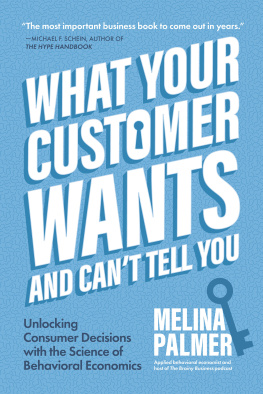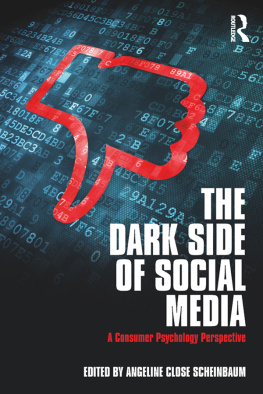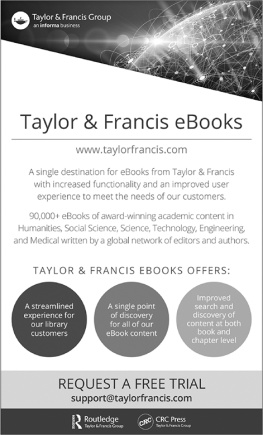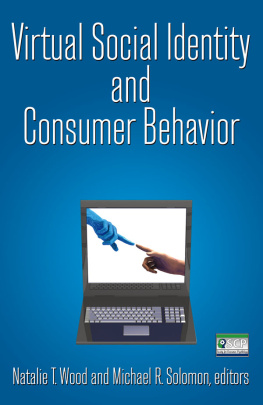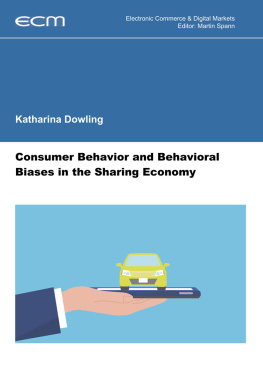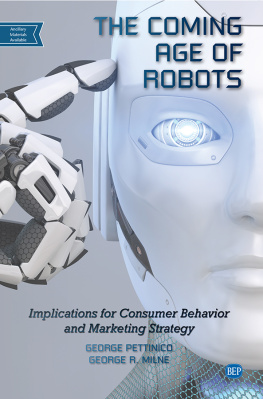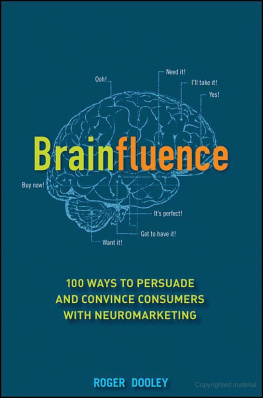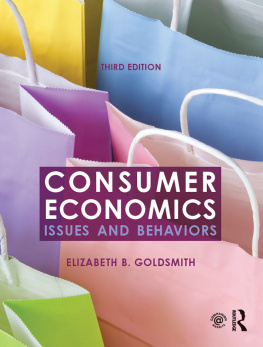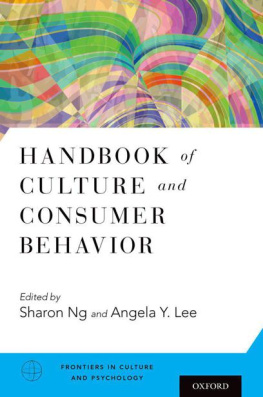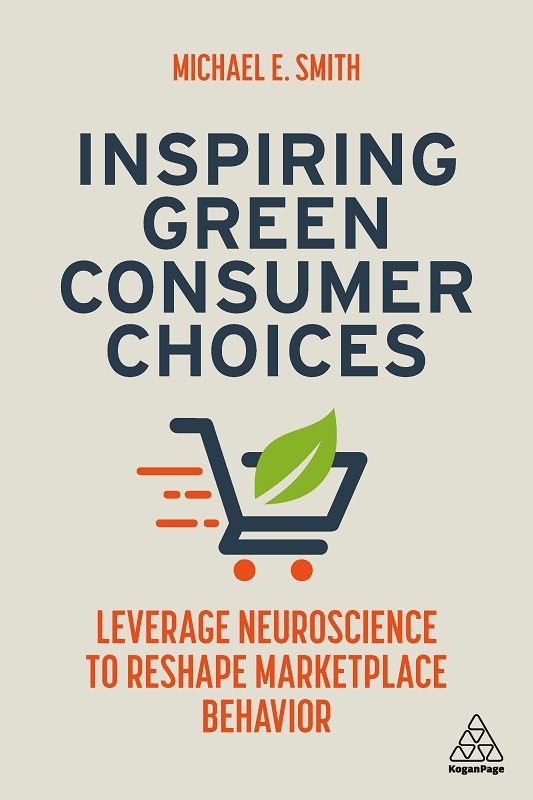
Contents
Landmarks
List of Figures
Page List
PRAISE FOR INSPIRING GREEN CONSUMER CHOICES
Marketers are increasingly recognizing the value of viewing consumer behavior through the lenses of neuroscience and behavioral economics. This ground-breaking new book extends the application of such insights to the problem of encouraging sustainable consumption. In it the author outlines pathways to accelerate the transition to a greener marketplace. A must-read!
Carla Nagel, Executive Director, Neuromarketing Science and Business Association
This much-needed book lays the ground for public and private organizations to take action that promote sustainable behaviors in consumers and citizens. Dr. Michael Smith leverages his expertise in consumer neuroscience and the behavioral sciences to develop a practical guide that could help mitigate the impact of the traditional consumer economy on the planet through changes in consumer behavior.
Manuel Garcia-Garcia, PhD Global Lead of Neuroscience, Ipsos
The gap between consumers good green intentions and their actual behavior is a key leverage point in the urgent fight for a greener economy. This book will help anyone in the business of marketing and selling understand the reasons for this gap, so they can develop ways to overcome it. Its rare that a book on consumer behavior has historic importance but I believe this one truly does. The message is clear: to save the planet we must understand the human mind.
Darren Bridger, Chief Research Officer at CloudArmy and author of Neuro Design
In this terrific new book, Michael E. Smith applies his deep knowledge of both brain science and consumer behavior to answer one of the most challenging questions of our time: how can we change the mental models that guide consumer behavior to encourage more sustainable and environmentally-friendly choices in the marketplace? The answer is often surprising and counterintuitive. If you care about practical solutions for the planet and the future of humanity, you need to read this book, closely and without delay.
Stephen Genco, author of Intuitive Marketing and Neuromarketing for Dummies
For Huxley, Jennifer and Linda
Contents
LIST OF FIGURES
I would like to thank my editors Kathe Sweeney and Heather Wood, as well as the production and marketing staff at Kogan Page, for their help in bringing this book to life. For their early influences on my subsequent path towards becoming a cognitive psychologist, I would also like to thank Professors Richard Nisbett and the late Stephen Kaplan from the University of Michigan, who helped me to better understand how people think about people and about their relationship to the environment they inhabit. And I am indebted to the friends and colleagues Ive worked with in the market research industry over the years, who through discussion and debate (often late at night and in far-flung corners of the world), have provided me with invaluable insights into the underlying drivers of consumer behavior. They are too numerous to fully acknowledge here, but I would especially like to thank David Brandt, Steve Genco, Thom Noble, Horst Stipp, Deepak Varma and Joe Willke for their tutelage and support.
This book explores the ways in which the traditional consumer economy has impacted the ecosystem we inhabit, and the prospect that an improved understanding of consumer behavior might contribute to efforts to mitigate that impact. I started it one night in the spring of 2020, when in the moonless dark with Venus rising to the west above where I stood on the coast of Southern California, the crests of the ocean waves lit up in a phosphorescent blue glow. So did the wake-patterns trailing the boards of the otherwise invisible surfers riding the curls. And as amazed spectators walked along the waterline, for a moment they too left trails of glowing blue footprints behind them. The light show was one of the more charming, and less awful, examples of a growing global weirding, the oft-cited term used in reference to the emergence of a variety of extreme events accompanying the planets warming and the associated degradation of the biosphere.
In that case the weirdness was the result of an unprecedented bloom of a type of nitrogen-dependent and warm-water-loving bioluminescent single-cell dinoflagellate named Lingulodinium polyedra. Under the right circumstances this photosynthetic microorganism emits brilliant flickers of light when it is jostled en masse by breaking surf or a passing boat. While lovely to watch, this event occurred as a result of an unnatural influx of pollution from runoff of agricultural chemicals, which in turn was the result of a highly abnormal seasonal variation in typical rainfall patterns. Fortunately this algal bloom turned out to be both entertaining and relatively harmlessother red tide events that we have experienced in recent years were from microorganisms that were more toxic and caused die-offs of local fish, birds, seals, and sea lions. Both the brilliant and the bad blooms are becoming more frequent as the local waters grow warmer.
This odd aquatic phenomenon was made more special by the fact that the beach had only recently reopened for careful visitation. The audience for the lightshow was tentative and a little disoriented, having just been liberated from sheltering in their homes for weeks in response to the COVID-19 pandemic that spread quickly around the globe as a result of our deeply interwoven consumer economy. Weeks during which, for the first time in their lives, the audience also experienced the fragility of that interconnectivity as supply chains for common consumer products ranging from toilet paper to dried pasta were disrupted worldwide.
While the quality of life for most of these people had until very recently been pretty comfortable, they now suddenly faced widening political strife, a shocking economic recession, increasingly obvious amounts of plastic detritus on the beach, and growing concern about the implications of accelerating coastal erosion from sea-level rise. There was also an expectation that the coming summer would only grow hotter, and a budding realization that the future was more uncertain than ever and that business-as-usual was not working anymore.
This book will explore the role of consumer behavior in creating that uncertainty and the potential for changing it to enable a more sustainable and less threatening future. In it we will take a deep dive into the brain of the consumer and the consequences of the way that organ works for choices in the marketplace. And we will investigate strategies that marketers and policymakers can adopt to move those choices in a more promising direction.
The coming chapters outline an overview of the modern view of consumer decision-making that is being informed by advances in neuroscience, experimental psychology, behavioral economics, and other disciplines. They will also identify some potential barriers to the transition to more sustainable patterns of consumption implied by this developing view of the consumers brain/mind. In them we will consider examples, policies, and best practices from the applied behavioral science literature that illustrate how to best reduce those barriers and minimize cognitive friction along the road to a circular economy.
Well start by asking the question, How did we get here? takes a deep dive into the brain mechanisms underlying purchase decisions, how those mechanisms bias consumption towards short-term goals rather than longer-term considerations, and how they can be hijacked by marketing efforts to drive unsustainable consumption.
Next page

